2025 Wisconsin Agricultural Outlook Forum
The Contribution of Ag to the Wisconsin Economy
Summary
This presentation offers an overview of the agricultural economy in Wisconsin, highlighting significant contributions and the evolving landscape. In his overview, Jeff Hadachek, Extension specialist assistant professor of agricultural and applied economics and for the UW-Madison College of Agricultural and Life Sciences, discusses in detail a comprehensive report he co-authored with Dr. Steven Deller that analyzes agricultural contributions, with a focus on food processing and on-farm production.
The insights gained from the report not only provide a snapshot of the current state of agriculture in Wisconsin but also lay the groundwork for future exploration and policy development aimed at fostering a sustainable agricultural ecosystem that benefits both the economy and the environment. By recognizing the dual importance of agricultural productivity and environmental stewardship, stakeholders can work towards an integrated approach that ensures the longevity and health of Wisconsin’s agricultural landscape.
Highlights
Economic Contribution: Wisconsin agriculture is a $116 billion industry, accounting for about 14% of the state’s overall economy.
Dairy Dominance: The dairy sector is a significant player, contributing approximately $53 billion in industrial revenue and employing about 120,000 individuals.
Evolving Landscape: A divergence is noted between the growth of food processing and the decline in on-farm contributions over the last few decades.
Employment Trends: Although revenues have increased, agricultural employment has seen a decline from previous years, indicating potential shifts in the industry’s workforce dynamics.
Environmental Impact: Agriculture contributes approximately 17.8 million metric tons of CO2 emissions, highlighting the environmental challenges associated with the sector.
Geographical Insights: While agricultural activities are often associated with rural areas, significant food processing contributions come from urban counties such as Milwaukee and Green Bay.
Future Trends: The report sets a baseline for future analysis of agricultural contributions to the economy and the environment, with hopes for better understanding over time.
Insights
Economic Growth vs. Employment Decline: The report indicates that while the overall revenue from agriculture has grown by 11% since the last report, employment in the sector has decreased. This suggests a shift towards automation or more capital-intensive farming practices, where fewer workers are needed to generate higher revenues. The decline in employment raises questions about the sustainability of agricultural jobs and the potential impact on rural communities that are heavily reliant on these positions.
Dairy Industry as a Pillar: Wisconsin’s dairy industry remains a cornerstone of its agricultural economy, with a location quotient indicating that it is significantly more dominant in Wisconsin compared to the national average. This not only highlights Wisconsin’s competitive advantage in dairy farming but also suggests the need for continued investment in this sector to maintain its strength against fluctuating market conditions and potential climate impacts.
Food Processing Growth: The growth in food processing, particularly in dairy processing, showcases an essential shift in the agricultural landscape of Wisconsin. The interdependence between on-farm production and food processing signals a need for policies that support both sectors to ensure they can thrive together, enhancing supply chain efficiencies and fostering local economies.
Urban-Rural Interconnection: The findings reveal that urban areas play a significant role in supporting the agricultural economy, particularly through food processing. This challenges the traditional view of agriculture being solely a rural endeavor and underlines the importance of urban markets in sustaining agricultural viability, suggesting that policies should consider these interconnected dynamics.
Environmental Accountability: The inclusion of environmental contributions in the report, particularly regarding greenhouse gas emissions, emphasizes the dual role of agriculture as both an economic driver and an environmental factor. This correlation between economic activity and environmental impact necessitates a balanced approach to agricultural policies, ensuring that growth does not come at an unsustainable ecological cost.
Need for Continuous Monitoring: The cyclical nature of agricultural contributions necessitates ongoing research and data collection. The report aims to establish a baseline for future assessments, which will help stakeholders track trends and develop strategies responsive to changing economic and environmental conditions, reinforcing the importance of agriculture’s role in the state’s economy.
Regional Contributions: The geographical distribution of agricultural contributions, with significant processing activities occurring in urban centers, suggests that future agricultural strategies should account for regional strengths and weaknesses. This could lead to more tailored approaches that address specific community needs, enhancing the overall effectiveness of agricultural policy initiatives.
Transcript
The Contribution of Ag to the Wisconsin Economy
00:02
I just want to give sort of a a brief overview of the size and shape of Wisconsin um agricultural economy and its contribution Wisconsin economy more broadly can you hear him good um and so to do this um I'm going to give an overview of a report that Dr Steve Del and I pulled together and and published earlier um that's updating the contribution of Agriculture to the Wisconsin economy and and so if you've been around the a industry for um the last few decades you know that Dr Del um puts out these reports every 5 years to
00:37
give sort of an update of the situation and understand the trends um of where our industry is going in and uh more broadly how our agric how agriculture contributes to our local economy and our state economy generally and so this report is available online I'm not going to go into every detail of it today but generally what it looks like is a 40 page um detailed overview report report which is the main report and then there is a um summary as well and then um for the key Industries in the state we have
01:09
um a two-page fact sheet and so if you're working in um beef you can go and grab some of those numbers that um we're going to be talking about today um for specifically for the beef industry I'll put up a QR code there's going to be another QR code at the end if you're at this report um more broadly so very generally I want to start with some Trends and some historical um perspective on where we find oursel today and um how we're going to talk about this conversation um for agriculture's contribution to the
01:39
economy and so what we're going to do is we're going to break this down into and food processing sectors and we primarily do that uh because over the last 50 to 60 years the Dynamics of those Industries have been very different what we've seen is a um growth very generally in um the food processing sector in Wisconsin whereas um a decline in the on to GDP and so this chart just displays uh the black line is overall um all Industries gross domestic product um the blue line is is GDP of food processing and on Farm is um the red uh
02:18
line and so there's a lot of volatility in the on Farm um sector and other than a few years uh in recent in 2021 and 2022 um we've seen a lot generally a decline in um on Farm contribution to GDP looking more specifically at um food processing and comparing that to the rest of the us what we see is that that growth in food processing in Wisconsin growing relative relatively more than um the rest of the US food processing sector and especially more than um our neighboring states in the Great Lakes region and along with that
02:55
has come um growth in um employment employed in food processing and so what we've had and where we find ourselves today is this sort of um between Divergence between food processing and on Farm contribution in terms of what makes up the agriculture industry and who's employed by the agriculture industry okay and so the the first part stage of this analysis um that we're going to do is we're going to look at um economic clusters and by um measure our measurement of a location quotient and what this measures is
03:29
Wisconsin relative advantage in producing and in that industry relative to the rest of the United States and so if you find yourself if an industry finds itself in the upper right hand quadrant that means that it is a relative advantage to and it is growing from that point in 2020 um 2001 if it's in the upper leftand quadrant um it is not considered a strength of Wisconsin but it it has grown um in in the last 20 years in the bottom leftand corner it's it's if it's a weakness and it's declining and in the
04:02
bottom um it is a strength but it's a decline and so maybe it's a Potential Threat to uh Wisconsin losing that advantage in the future and so just very briefly what we can take a look at um and probably unsurprising to a lot of us is that we see that Dairy um for on Farm production Wisconsin is relatively advantaged in in it's not surprising to any of us but that gives us some quantitative measures as to how much um an advantage Wisconsin is in Dairy and so that number is about seven and a half meaning that Wisconsin
04:36
is about seven and a half times more um has a seven and a half times larger dairy industry than the the US average some surprising things Le surprising to me as a newcomer to Wisconsin that fur bearing animals is um one of Wisconsin's best advantages it's not a large industry which is indicated by that small circle but um we dominate fur bearing animals in Wisconsin and you see then a lot of other Industries U which include um are slight advantages in Wisconsin but there hasn't been a lot of movement in the last 20 years in terms
05:09
of on Farm production then looking at the food processing side of this um sort of correspondingly we see a large strength in the dairy um processing um um sector and and so uh again those work in in in a symbiotic relationship where they support each other and that's I think a really important thing to take away um the one thing I'll will highlight other thing I'll highlight on this is we see a decline in the last 20 years in in fruit and vegetable canning and processing um this has been a trend
05:40
within that industry for a while and I think this gives substance to that that it is a strength in Wisconsin but we've seen a decline in the last 20 years um as as a result of some changes in the demand um side of things and and so uh this would be considered a Potential Threat if we're going to use that terminology again at Wisconsin losing that that Advantage um this time around next stage of this is we're going to actually then look at the contribution analysis um and I want to talk about very briefly as to how we get
06:10
some of these numbers and so for illustration purposes let's say we take a um a cheese uh processor a che a dairy processor that makes cheese um and they employ four people in our economy so to look at the direct effect is how many how much sales do does that that company generate and so that's what we're going to call the direct effect um and they they employ four people and that's the direct effect of unemployment but that cheese maker also supports other sectors of the economy by purchasing um inputs
06:41
and in this case primarily milk ify that as an indirect effect those two um inputs and the processing working in sort of this symbiotic relationship um and that that Dairy employs three people let's say there is also um an induced effect is that those four people that worked for that cheese maker are going to go and and spend money on in our local grocer hospitals um on our in our energy and so those individuals living in our local communities support um other Industries in that Community as well and so when we
07:14
talk about the contribution of Agriculture we're taking that direct effect plus the indirect effect and adding it to that induced effect um and so that's where we these numbers just to give you an idea we also know that these industries are paying taxes and are contrib ruting to government revenue which can go then to support um Revenue um infrastructure and and other government programs right so um these industries are integrated into our um communities and this is a way we can measure that as
07:43
a so the big uh highlight number that you're going to see often times cited from this report is that Wisconsin agriculture according to the 2022 numbers that we've done this with is $116 billion industry that's an 11% increase from the last time that this report was completed in 20 um 19 um have seen growth in terms of overall industrial revenues um and it employs 350,000 people in the state which is a decline though um from that those 2017 numbers so we've seen growth in um revenues but a decline in in terms of
08:18
employment from the dairy perspective um we we also break that out into Dairy find that Dairy um in total contributes to about $53 billion in industrial revenue and employs 120,000 um folks in the state in terms of percentage that that equates to that was um agriculture is about 14% of the overall um Wisconsin economy about one in every 10 or one in every 11 people um and about 9 and a half% of Wisconsin's Workforce are employed in agriculture to some extent in terms of industrial revenues uh agriculture contributes about $8
08:58
billion dollar um annually in revenues um to to in um 5 billion of that goes to Federal um 1.7 goes to State the state government and about 1 billion come goes to to local governments um and it's broken down again um for dairy specifically as well now the really interesting thing about this actually uh for me coming at this as a newcomer for the first time is these um where this uh industry is happening um perhaps unsurprisingly on on the left hand figure you'll see the on Farm portion of um agricultural
09:35
contributions which is really sort of centered in sort of that southern half of the state south central part and then maybe East um Central is aligning with where a lot of our Farms are located in the state um but what was more surprising and and when we look at the right- hand figure is where that those food processing dollars come from it comes from our Urban counties it comes from Green Bay it comes from Milwaukee and it comes from DNE County and so that's just to say that um when we do this every time around uh we we think of
10:04
Agriculture as um located in our rural areas but the urban counties do play a big p part in supporting the industry as a whole and then the last piece of this is that we did something new this time around was to understand what agriculture's contribution um to the environment is and and specifically counting greenhouse gas emission and phosphorus releases to water and how much water is actually used particularly from our irrig agriculture in the state and so the number that we have and I'll just highlight greenhouse gas emissions
10:34
in particular is that there's agriculture contributes about 17.8 uh million metric tons of CO2 emissions equivalent which correspondingly is about 14% of the state economy so if you uh if you think back to what our the economic contributions were of the state and we compare that to what the environmental contributions are they're right in line with each other and and if we break that down that all agriculture into which Industries are contributing the most within agriculture it's it's beef farming and and dairy so uh
11:07
that's just to say that the economic and environmental contributions um are are really correlated with one another just based on the size of it so I'll wrap up today and and just say that um to to provide some of those highlight numbers that Wisconsin agriculture is6 indry employing 9 and a half% of the state um we we've seen this continued Divergence between on farm and the food processing sector in terms of what makes up agriculture food processing is is continuing to grow and that as a national Trend um but it seems to be
11:40
more so um Happening Here in Wisconsin thinking about those numbers for environmental contributions this is a baseline the first time that we've done this hopefully when we re revisit this again we can understand some more of what the trends and changes are over time
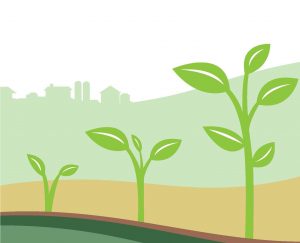
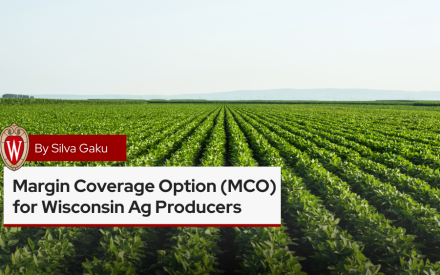 Margin Coverage Option (MCO) for Wisconsin Ag Producers
Margin Coverage Option (MCO) for Wisconsin Ag Producers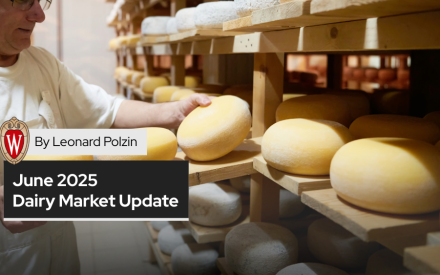 Dairy Market Dynamics and Domestic Constraints: A Dairy Sector Assessment as of June 2025
Dairy Market Dynamics and Domestic Constraints: A Dairy Sector Assessment as of June 2025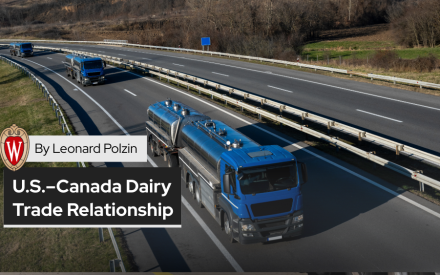 U.S.–Canada Dairy Trade Relationship (2025–Present)
U.S.–Canada Dairy Trade Relationship (2025–Present)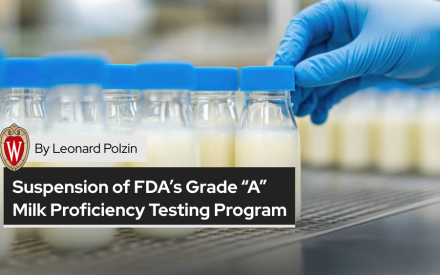 Suspension of FDA’s Grade “A” Milk Proficiency Testing Program – A Comprehensive Analysis
Suspension of FDA’s Grade “A” Milk Proficiency Testing Program – A Comprehensive Analysis


